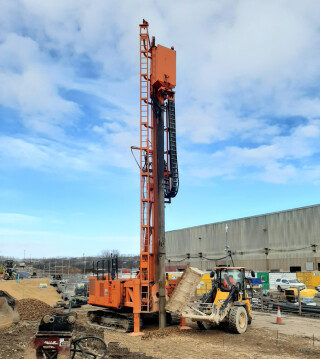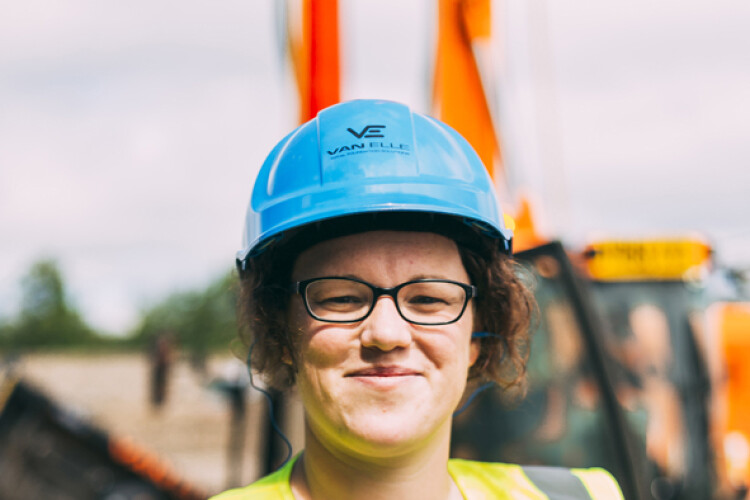Earlier this year, piling and foundations specialist Van Elle completed a contract to install 201 vibro stone columns as part of the £35m Sunderland Strategic Transport Corridor phase three project (see p25). The contract came during a very successful first year since the firm moved into the ground improvement sector, which has so far seen it undertake more than 40 individual projects.
Van Elle launched its ground improvement division in April 2019 in response to enquiries from clients looking for alternatives to augered, bored and driven piling. “A lot of clients – especially in housing – were saying it would be good if we could do vibro,” explains the company’s ground improvement director Claire Garrett. “It complements the other techniques we do.”
The firm has made a serious commitment to the ground improvement market, investing in a new office, plant and equipment, and specialist operatives and staff – including Garrett herself, who was brought in from Balfour Beatty Ground Engineering to head up the new division. She and her team are based at Van Elle’s new North West office in Birchwood, near Warrington, which was identified as an ideal location to serve the large concentration of major housebuilders based in the North.
This article was first published in the Jul/Aug 2020 issue of The Construction index magazine. Sign up online.
Initially, the division is concentrating on vibro stone columns, because that is where the biggest demand is. But it does plan to expand into other forms of ground improvement in future.
Vibro columns are a quick, and usually cost-effective, alternative to piling and grouting to reduce settlement and increase the load-bearing capacity of weak ground. They are typically used as a ground improvement technique before building lightweight structures like housing, industrial units and schools, but can also be used to stabilise embankments and other earthworks on civils infrastructure projects.
The columns are installed on a grid using a vibrating poker (known as a vibroflot), mounted on a special vibropiling rig, and driven into the ground, with or without air flush, to the desired depth. Van Elle uses two different installation methods, known as “top feed” and “bottom feed”, to create the columns themselves.
The top feed method is typically used when the soil is stable enough for the vibroflot to be removed, leaving an open bore that is filled with stone aggregate from the working platform level. The bottom feed method is used if the ground is not stable enough to support an open bore – for example in very soft soils or where there is a high water table. In this case, stone or concrete is fed into the hole through a tube attached to the vibroflot, which compacts the material to form a column as it is withdrawn.
“Vibro is very versatile,” explains Garrett. “It will suit anything from housing, retail and education to industrial and commercial; any type of structure as long it is lightweight. It is ideal for buildings that are one to three storeys high, and where the ground isn’t too stiff. But it can also be used in civils – for example for embankment support.”
Garret says that, if the load and bearing capacity parameters suit a vibro stone column solution, it will usually work out at around a third of the cost of conventional piling, which can make the difference between a building project going ahead or not. “It gives us an opportunity to value engineer. A client might send an enquiry to the piling division, but if we can come up with a vibro solution it may mean that the job can then get over the line.”
The UK vibro column market is fairly competitive: according to Garrett, Van Elle has six main competitors offering this technique, all of which turn over around £5m a year in vibro stone or concrete columns. Van Elle initially entered the market by converting two of its traditional piling rigs into vibropiling rigs, but has since built two brand new rigs to its own specification.

“These rigs were developed, designed and self-built in house,” says Garrett, who adds that these two machines have been built with Tier 5 engines to meet the most stringent standards for diesel engine emissions. “That means we’re geared up for future markets and it will allow us to compete for big projects,” she adds. “You can’t buy rigs off the shelf with that type of engine, so we developed them in house. It was quite an investment in this type of plant.”
Demand for its vibro services since the April 2019 launch has led Van Elle to add a further two vibropiling rigs to its stable, both bought second-hand, taking the total to six.
Van Elle’s first vibro stone column installation contract was at a site in Wigan for a major housebuilder, just 15 miles away from the firm’s new Birchwood office. The company used the top feed method to install vibro stone columns that were designed to improve the bearing capacity of the existing ground in order to support standard strip footings for the new homes.
Since then, Van Elle has completed over 40 individual vibro projects, many of which involved the ground improvement division working in collaboration with the housing or piling division. Clients include national housebuilders and large main contractors.
The Sunderland Strategic Transport Corridor contract, completed in April 2020, was Van Elle’s first vibro contract on a civils infrastructure project. Since completing that one, the company has tendered for a number of vibro contracts for earthworks structures, and is confident it has the capability to deliver vibro column solutions on major infrastructure schemes, including HS2.
Van Elle chose to launch the new ground improvement division with vibro columns as this tends to be the most cos-effective alternative to piling if the ground conditions and required bearing capacity are suitable. However, it does plan to offer other ground improvement techniques in future.
“Our aim was to start off doing vibro, but we want to offer other disciplines as we grow,” confirms Garrett. Among the techniques likely to be included in Van Elle’s portfolio are controlled modulus columns (CMCs) – also known as rigid inclusions – which Garrett describes as a “bridge between vibro and piling”.
CMCs are also designed to reduce settlement and increase the bearing capacity of weak soils, but are suitable for a wider range of soil types and can be used for higher and more heavily loaded structures than vibro columns.
The company sees the launch of its ground improvement division as a natural extension to its existing range of services, which includes site investigation and geotechnical engineering, as well as piling and foundations.
"It gives us an opportunity to value engineer. A client might send an enquiry to the piling division, but if we can some up with a vibro solution it may mean the the job can then get over the line." Van Elle ground improvement director Calire Garrett

Got a story? Email news@theconstructionindex.co.uk



